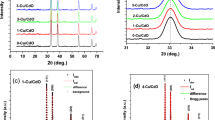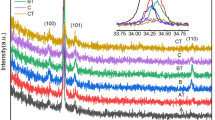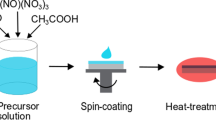Abstract
In this work, dark Ti(OxH)y films were obtained by DC magnetron reactive sputtering under different oxygen partial pressures (PO2) starting from a high base pressure chamber atmosphere (10−5 mbar) with the purpose of investigating the visible light absorption dependence of the hydrogen content and stoichiometry. The TiOx film compositions, thicknesses, and elemental depth profiles were measured by ion beam analysis (IBA) techniques in a self-consistent approach. The optical properties were investigated by visible and near-infrared spectrophotometry, and the crystallography was examined by small-angle X-ray diffraction. The films deposited at a low PO2 were dark, and as the partial oxygen pressure increases, they became transparent. The IBA showed that the hydrogen content exponentially decreased as the PO2 increased. The optical constants for the films, n and k, are dependent on oxygen and hydrogen ratio as well as the optical band gap that can be modulated from 0.40 to 3.25 eV, and thus a significant improved PEC activity. These modulations may be useful for optical or electronic devices as a variable semiconductor or dielectric layer.









Similar content being viewed by others
References
B. Zhang, C. Xu, G. Xu, S. Tan, J. Zhang, Amorphous titanium dioxide film with improved electrochromism in near-infrared region. Opt. Mater. (Amst) 89, 191–196 (2019). https://doi.org/10.1016/j.optmat.2019.01.034
R.B.P. Marcelino, C.C. Amorim, M. Ratova, B. Delfour-Peyrethon, P. Kelly, Novel and versatile TiO2 thin films on PET for photocatalytic removal of contaminants of emerging concern from water. Chem. Eng. J. 370, 1251–1261 (2019). https://doi.org/10.1016/j.cej.2019.03.284
A. Obstarczyk, D. Kaczmarek, D. Wojcieszak, M. Mazur, J. Domaradzki, T. Kotwica, R. Pastuszek, D. Schmeisser, P. Mazur, M. Kot, Tailoring optical and electrical properties of thin-film coatings based on mixed Hf and Ti oxides for optoelectronic application. Mater. Des. 175, 107822 (2019). https://doi.org/10.1016/j.matdes.2019.107822
Q. Jin, W. Wen, J.Q. Bai, J.M. Wu, Construction of Ni-doped belt-on-belt TiO2 thin film to assist photodegradation of rhodamine B in water. Thin Solid Films 683, 111–117 (2019). https://doi.org/10.1016/j.tsf.2019.05.040
J. Kim, S. Lee, H. Im, The effect of target density and its morphology on TiO2 thin films grown on Si (100) by PLD. Appl. Surf. Sci. 151, 6–16 (1999). https://doi.org/10.1016/S0169-4332(99)00269-X
S. Lin, Y. Chen, C. Wang, Effect of heat treatment on electrochromic properties of TiO2 thin films. J. Solid State Electrochem. 12, 1481–1486 (2008). https://doi.org/10.1007/s10008-007-0502-2
Z. Wang, U. Helmersson, P.-O. Käll, Optical properties of anatase TiO2 thin films prepared by aqueous sol–gel process at low temperature. Thin Solid Films 405, 50–54 (2002). https://doi.org/10.1016/S0040-6090(01)01767-9
A. Miyamura, K. Kaneda, Y. Sato, Y. Shigesato, Effects of internal stress on photocatalytic properties of TiO2 films. Thin Solid Films 516, 4603–4608 (2008). https://doi.org/10.1016/j.tsf.2007.05.079
L.J. Meng, M. Dos Santos, The influence of oxygen partial pressure on the properties of DC reactive magnetron sputtered titanium oxide films. Appl. Surf. Sci. 68, 319–325 (1993). https://doi.org/10.1016/0042-207X(94)90080-9
K. Yoshimura, T. Miki, S. Tanemura, TiO2 electrochromic thin films by reactive direct current magnetron sputtering. J. Vac. Sci. Technol. A 2673, 1–5 (2014). https://doi.org/10.1116/1.580941
M.R. Hantehzadeh, M.A. Amouha, S. Solaymani, T. Osati, B. Ghobadi, Physical properties of titanium oxide thin films prepared by DC magnetron sputtering: Influence substrate temperature and O2/Ar in the gas mixture. J. Fusion Energy 32, 622–626 (2013). https://doi.org/10.1007/s10894-013-9626-9
S. Schiller, G. Beister, W. Sieber, G. Schirmer, E. Hacker, P. Section, F. Jena, Influence of deposition parameters on the optical and structural properties of TiO2 films produced by reactive d.c. plasmatron sputtering. Thin Solid Films 83, 239–245 (1981). https://doi.org/10.1016/0040-6090(81)90673-8
Â. Mu, H. Selhofer, R. Müller, Comparison of pure and mixed coating materials for AR coatings for use by reactive evaporation on glass and plastic lenses. Thin Solid Films 351, 180–183 (1999). https://doi.org/10.1016/S0040-6090(99)00305-3
N. Özer, Reproducibility of the coloration processes in TiO2 films. Thin Solid Films 214, 17–24 (1992). https://doi.org/10.1016/0040-6090(92)90450-P
H. Yu, Y. Li, L. Zhao, G. Li, J. Li, H. Rong, Z. Liu, Novel MoO3 -TiO2 composite nanorods films with improved electrochromic performance. Mater. Lett. 169, 65–68 (2016). https://doi.org/10.1016/j.matlet.2016.01.097
M.E. Yeoh, K.Y. Chan, Efficiency enhancement in dye-sensitized solar cells with ZnO and TiO2 blocking layers. J. Electron. Mater. 48, 4342–4350 (2019). https://doi.org/10.1007/s11664-019-07207-5
T. Wang, M. Zhang, K. Liu, J. Jiang, Y. Zhao, J. Ma, T. Liu, The effect of the TiO2 film on the performance of the optical fiber SPR sensor. Opt. Commun. 448, 93–97 (2019). https://doi.org/10.1016/j.optcom.2019.05.023
X. Chen, L. Liu, P.Y. Yu, S.S. Mao, Increasing solar absorption for photocatalysis with black hydrogenated titanium dioxide nanocrystals. Science (80-.) 331, 746–750 (2011). https://doi.org/10.1126/science.1200448
X. Wang, L. Mayrhofer, M. Hoefer, S. Estrade, L. Lopez-Conesa, H. Zhou, Y. Lin, F. Peiró, Z. Fan, H. Shen, L. Schaefer, M. Moseler, G. Braeuer, A. Waag, Facile and efficient atomic hydrogenation enabled black TiO2 with enhanced photo-electrochemical activity via a favorably low-energy-barrier pathway. Adv. Energy Mater. 9, 1900725 (2019). https://doi.org/10.1002/aenm.201900725
Y. Liu, L. Tian, X. Tan, X. Li, X. Chen, Synthesis, properties, and applications of black titanium dioxide nanomaterials. Sci. Bull. 62, 431–441 (2017). https://doi.org/10.1016/j.scib.2017.01.034
A.R. Bally, P. Hones, R. Sanjinés, P.E. Schmid, F. Lévy, Mechanical and electrical properties of fcc TiO1+x thin films prepared by r.f. reactive sputtering. Surf. Coat. Technol. 108–109, 166–170 (1998). https://doi.org/10.1016/s0257-8972(98)00629-x
E. Şilik, S. Pat, S. Özen, R. Mohammadigharehbagh, H.H. Yudar, C. Musaoğlu, Ş. Korkmaz, Electrochromic properties of TiO2 thin films grown by thermionic vacuum arc method. Thin Solid Films 640, 27–32 (2017). https://doi.org/10.1016/j.tsf.2017.07.073
M. Mayer, SIMNRA User´s Guide, Report IPP 9/113 (Max-Planck-Institut für Plasmaphysik, Garching, 1997)
J. Demarche, G. Terwagne, Precise measurement of the differential cross section from the 16O (α, α) 16O elastic reaction at 165° and 170° between 2.4 and 6.0 MeV. J. Appl. Phys. 100, 0–7 (2006). https://doi.org/10.1063/1.2402868
A.F. Gurbich, Evaluation of non-Rutherford proton elastic scattering cross section for carbon. Nucl. Instrum. Methods Phys. Res. Sect. B 136–138, 60–65 (1998). https://doi.org/10.1016/s0168-583x(97)00837-9
J. Cisneros, G. Rego, M. Tomyiama, S. Bilac, J. Gonçalves, A. Rodriguez, Z. Arguello, A method for the determination of the complex refractive index of non-metallic thin films using photometric measurements at normal incidence. Thin Solid Films 100, 155–167 (1983)
Z. El Mandouh, M. Selim, Physical properties of vanadium pentoxide sol gel films. Thin Solid Films 371, 259–263 (2000). https://doi.org/10.1016/S0040-6090(00)01003-8
M. Cesaria, A.P. Caricato, M. Martino, Realistic absorption coefficient of ultrathin films. J. Opt. (United Kingdom) 14, 105701 (2012). https://doi.org/10.1088/2040-8978/14/10/105701
J. Tauc (ed.), Amorphous and Liquid Semiconductors (Plenum, London, 1974). https://doi.org/10.1007/978-1-4615-8705-7
A. Pérez-Pacheco, C. Prieto, R. Castañeda-Guzmán, J. García-López, Influence of the growth conditions on the stoichiometry and on the optical properties of titanium oxide thin films prepared by reactive sputtering. Thin Solid Films 517, 5415–5418 (2009). https://doi.org/10.1016/j.tsf.2009.01.050
E.M. Girotto, I.A. Santos, Medidas de resistividade elétrica DC em sólidos: como efetuá-las corretamente. Quim. Nova 25, 639–647 (2002). https://doi.org/10.1590/s0100-40422002000400019
J.A. Thornton, Influence of apparatus geometry and deposition conditions on the structure and topography of thick sputtered coatings. J. Vac. Sci. Technol. 11, 666–670 (1974). https://doi.org/10.1116/1.1312732
S. Khan, I. Ahmed, A. Shah, Structural and optical properties investigation of DC magnetron sputtered β-TiO2 thin film. Appl. Surf. Sci. 317, 607–613 (2014). https://doi.org/10.1016/j.apsusc.2014.08.131
S. Schiller, G. Beister, W. Sieber, Reactive high rate D.C. sputtering: deposition rate, stoichiometry and features of TiOx and TiNx films with respect to the target mode. Thin Solid Films 111, 259–268 (1984). https://doi.org/10.1016/0040-6090(84)90147-0
B. Zhao, J. Zhou, L. Rong, Microstructure and optical properties of TiO2 thin films deposited at different oxygen flow rates. Trans. Nonferrous Met. Soc. China 20, 1429–1433 (2010). https://doi.org/10.1016/S1003-6326(09)60316-2
J.F. Ziegler, J.P. Biersack, in Treatise on Heavy-Ion Science, ed. by D.A. Bromley. The Stopping and Range of Ions in Matter (Springer, Boston, MA, 1985)
L. Meng, M. Andritschky, M.P. Santos, The effect of substrate temperature on the properties of sputtered titanium oxide films. Appl. Surf. Sci. 65–66, 235–239 (1993)
I. Luciu, R. Bartali, N. Laidani, Influence of hydrogen addition to an Ar plasma on the structural properties of TiO2–x thin films deposited by RF sputtering. J. Phys. D 45, 345302 (2012). https://doi.org/10.1088/0022-3727/45/34/345302
M. Chandra Sekhar, P. Kondaiah, B. Radha Krishna, S. Uthanna, Effect of oxygen partial pressure on the electrical and optical properties of DC magnetron sputtered amorphous TiO2 films. J. Spectrosc. 2013, 3–10 (2013)
M. Bouroushian, T. Kosanovic, Characterization of thin films by low incidence X-ray diffraction. Cryst. Struct. Theory Appl. 1, 35–39 (2012). https://doi.org/10.4236/csta.2012.13007
M. Zhang, G. Lin, C. Dong, L. Wen, Amorphous TiO2 films with high refractive index deposited by pulsed bias arc ion plating. Surf. Coat. Technol. 201, 7252–7258 (2007). https://doi.org/10.1016/j.surfcoat.2007.01.043
D. Pjevi, M. Obradovi, T. Marinkovi, A. Grce, M. Milosavljevi, R. Grieseler, T. Kups, M. Wilke, P. Schaaf, Properties of sputtered TiO2 thin films as a function of deposition and annealing parameters. Physica B 463, 20–25 (2015). https://doi.org/10.1016/j.physb.2015.01.037
B.S. Richards, Single-material TiO2 double-layer antireflection coatings. Sol. Energy Mater. Sol. Cells 79, 369–390 (2003). https://doi.org/10.1016/S0927-0248(02)00473-7
M. Mazur, D. Wojcieszak, J. Domaradzki, D. Kaczmarek, S. Song, F. Placido, TiO2/SiO2 multilayer as an antireflective and protective coating deposited by microwave assisted magnetron sputtering. Opto-Electron Rev. 21, 233–238 (2013). https://doi.org/10.2478/s11772
C. Deng, H. Ki, Pulsed laser deposition of refractive-index-graded broadband antireflection coatings for silicon solar cells. Sol. Energy Mater. Sol. Cells 147, 37–45 (2016). https://doi.org/10.1016/j.solmat.2015.11.043
Y. Zhao, T. Hou, Y. Li, K.S. Chan, S.-T. Lee, Effective increasing of optical absorption of TiO2 by introducing trivalent titanium. Appl. Phys. Lett. 102, 171902 (2013)
H. Jin, L. Wang, D.J. Searles, C. Sun, Comparison of the effect of hydrogen incorporation and oxygen vacancies on the properties of anatase TiO2: electronics, optical absorption, and interaction with water. Chin Sci. Bull. 59, 2175–2180 (2014). https://doi.org/10.1007/s11434-014-0229-2
Acknowledgements
The authors acknowledge the CAPES, CNPq, and the FAPESP (contract FAPESP2013/09105-0) who financially supported part of this study; To LAMULT (Unicamp-SP) for sample deposition and XRD facilities. To the Brazilian foundations, CNPq and CAPES, for their scholarships and research grants.
Author information
Authors and Affiliations
Corresponding author
Additional information
Publisher's Note
Springer Nature remains neutral with regard to jurisdictional claims in published maps and institutional affiliations.
Rights and permissions
About this article
Cite this article
Amorin, L.H.C., da Silva Martins, L., Urbano, A. et al. Influence of the hydrogen content on the optical properties of TiOx thin films. J Mater Sci: Mater Electron 31, 1672–1680 (2020). https://doi.org/10.1007/s10854-019-02685-z
Received:
Accepted:
Published:
Issue Date:
DOI: https://doi.org/10.1007/s10854-019-02685-z




